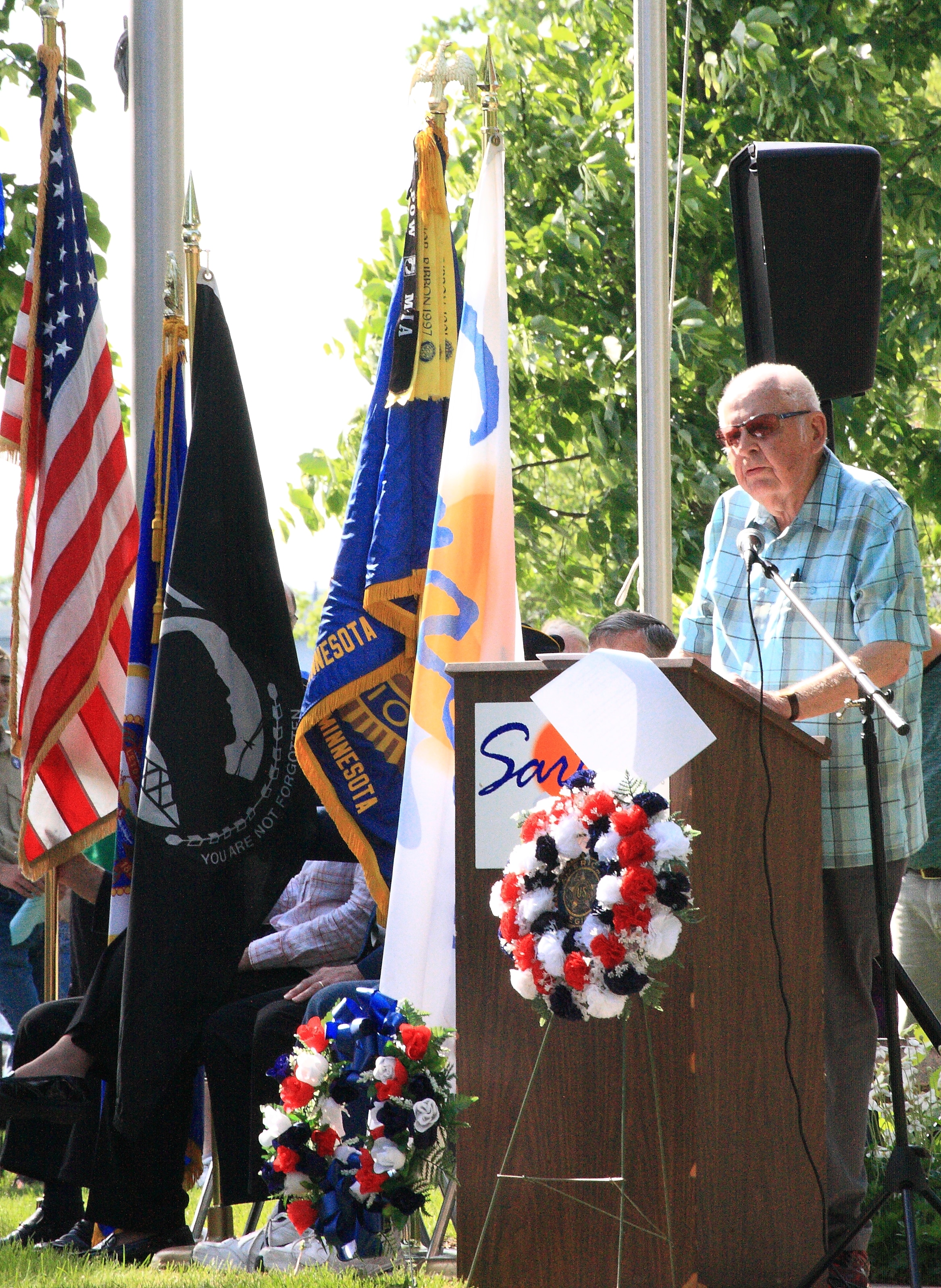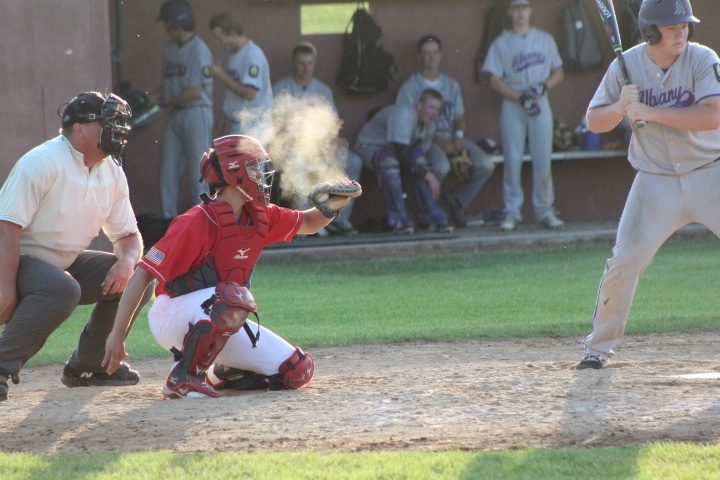by Dennis Dalman
news@thenewsleaders.com
Bill Morgan of Sartell has a lot to remember every Memorial Day because so many soldiers in so many wars have affected him personally, deeply, sorrowfully.
Morgan, a history writer and retired American Studies professor, was the keynote speaker at the Sartell Memorial Day ceremony May 28 in Veterans Park, the 150th anniversary of the founding of Memorial Day. Morgan’s memories visibly moved his listeners who reacted with a mixture of empathy and awe.
His speech was entitled “Wounds of War: Honoring America’s Veterans.”
Morgan’s relations were all touched by war, starting in the American Civil War (1861-1865). When that war first broke out, Morgan’s maternal great-grandfather, Jason Brown, who was a farmer in Wisconsin, enlisted and fought in the war’s first major battle – Bull Run, Virginia. Early on the afternoon of July 21, 1861 he died in the sad irony of “friendly fire.” His body was never found. That incident, Morgan said, remains for him and his family relations “Wound Number One.”
He then went on to recount five other “Wounds” – both physical and emotional.
Wound two
Brown’s son, Warrington Brown, also a farmer who was Morgan’s grandfather, enlisted three years after his father died in battle and joined another Wisconsin regiment. On April 2, 1865, seven days before the war’s end, Brown’s company was ordered to attack a fortification near Petersburg, Virginia. A rebel soldier shot Brown in the head. A surgeon removed the lead ball, which left a hole in Brown’s head with a silver plate inside. The doctor told Brown he would go insane by the time he turns 40, a fear he lived with constantly. But, lo and behold, Brown lived to the ripe old age of 92.
“Sitting on his lap when I was a child, I could see the hole with the silver plate at its base,” Morgan told the audience.
In 1934, that grandfather war hero, who was the last surviving Civil War veteran in the country, turned 88. He had been a founding member of Pipestone (Minnesota) County’s Grand Army of the Republic. At the G.A.R. meeting in 1934, Brown sat alone and then closed the meeting while toasting his comrades with a glass of wine.
Wound three
Morgan’s father, William Towner Morgan Sr., was too old to fight in World War I, but he belonged to the Home Guard. But then a wound he suffered led to tragic consequences for his wife, four children and an unborn fifth child. In December 1932, while hunting, he scratched himself on a barbed-wire fence. The untended wound led to influenza and then to spinal meningitis, causing William’s death one January day in 1933. He was only 49.
Wound four
The day after D-Day (June 6, 1944, the invasion of Europe by the Allied forces), Morgan’s brother was one of the soldiers who, after crossing the English Channel, stepped upon the bloody beaches of northern France as German occupiers let loose with a barrage of deadly force.
Alan Morgan walked upon one of the bloodiest landing areas, dubbed Omaha Beach. He was later wounded during the push to drive the Nazi invaders out of France.
During that same time frame, Alan’s (and Morgan’s) brother Bud parachuted into Germany where he set up an aid station in a farmer’s barn. Bud has been a battalion surgeon with the U.S. 17th Airborne Division.
Wound five
Morgan’s first cousin, Marine Sgt. Bill Genaust, was a combat photographer in World War II. On Feb. 22, 1945, he filmed the raising of the American flag on Iwo Jima island’s Mt. Suribachi. A photograph of that flag-raising remains one of the most iconic images in the history of photography.
Nine days after filming the flag-raising, Genaust died in a cave while flushing out Japanese holdouts. Since his body was never recovered, he is still listed as missing in action. He was one of 6,821 Marines killed in the 37-day struggle to wrest Iwo Jima away from Japanese control.
Wound six
Morgan’s oldest nephew, William Stannard Forman, was a St. John’s University student, Class of ’57, who decided to make service in the U.S. Navy his career.
During the Vietnam War, he was a pilot returning to the aircraft carrier, the USS Hornet, in the Bay of Tonkin. He was reported as missing in action on Jan. 22, 1966. His mother (Morgan’s sister) and her husband never ceased believing their son would someday come home. In another sad irony, his parents died three years before the government announcement that their son had been killed in action the day he was listed as missing. An enemy gunner had shot down his plane while he was coming in for a carrier landing.
“Those men made major sacrifices while serving their country,” Morgan said, “three of them the ultimate sacrifice.”
Sartell veterans
Morgan noted a brass plaque that hangs in the Sartell Community Center lists the names of 17 veterans from Sartell, including many with the last name “Sartell.” Earl, Victor and Norris Sartell served during World War I when Sartell’s population was only about 500. Eighty-five residents – including Charles, Richard, Roscoe and Thomas Sartell – fought in World War II. Seven of the 85 never returned from that war.
Morgan himself is a veteran who served for two years in the U.S. Army during peacetime in the 1950s.
“I would not exchange my own two-year peacetime Army service for the world,” he said. “ . . . Our group of 12 companions formed what has resulted in a 60-year bond. Of we five still alive, one will close the book on our experience, toasting with a glass of wine.”
Other highlights
The Sartell Memorial Day Service was moderated by Joyce O’Driscoll, the mother of State Rep. Tim O’Driscoll (R-Sartell) and former Sartell mayor, who also spoke at the event.
Other speakers included welcomes or comments by American Legion of Sartell Commander Chuck Haselkamp; Sen. Michelle Fischbach (R-Paynesville), who was just sworn in as the state’s new lieutenant-governor; Sartell police school-liaison officer Adam Vande Vrede (a U.S. Marine veteran), city council member David Peterson (also a veteran), student Jasmine Al-Fraijat, who gave a reading of the poem “Flanders Field;” Pastor Jim Goodew of Faith Baptist Fellowship; and Rollie Weis, a Sartell World War II veteran who is one of the oldest, if not the oldest, World War II veteran still living, who read the Legion Prayer.
Guest bagpiper Joe Linneman performed tunes, and the Sartell High School Marching Band played a stirring series of patriotic songs.
There was, as always, the placing of the wreath, the planting of flags by Scouts, a rifle squad, a gun salute and the playing of taps.
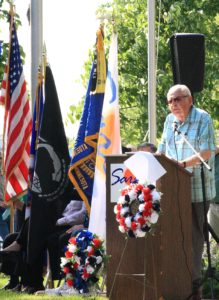
Keynote speaker Bill Morgan of Sartell takes the podium May 28 for his talk, “Wounds of War: Honoring America’s Veterans,” at the Sartell Memorial Day Ceremony in Veterans Park.
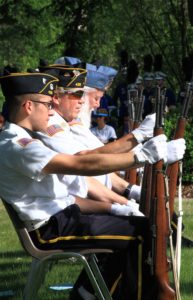
Members of American Legion Post 277 of Sartell listen quietly to Bill Morgan’s speech May 28 at the Sartell Memorial Day ceremony in Veterans Park.
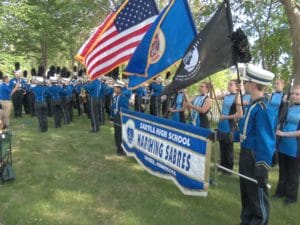
The Sartell High School Marching Band performs a stirring series of patriotic songs during the 2018 Memorial Day ceremony in Sartell.
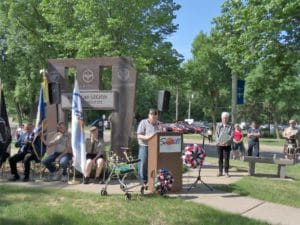
World War Ii veteran, Rollie Weis of Sartell, reads the Legion Prayer during the Memorial Day ceremony May 24 in Veterans Park. Weis is one of the oldest, if not the oldest, World War II veteran still living.
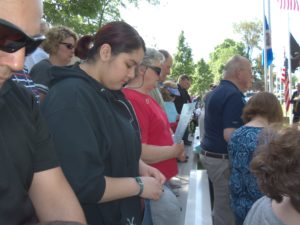
Audience members bow their heads in prayer during a blessing given by Pastor Jim Goodew of Faith Baptist Fellowship Church.
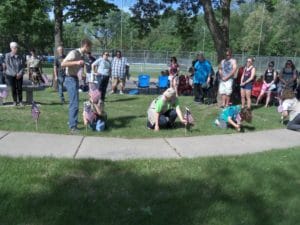
Sartell Boy and Girl Scouts plant flags at the close of the Memorial Day ceremony in Veterans Park, Sartell.
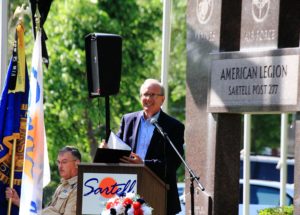
State Rep. Tim O’Driscoll (R-Sartell), addresses the crowd at the annual Memorial Day ceremony at Sartell’s Veterans Park May 28. O’Driscoll started this event about 12 years ago.
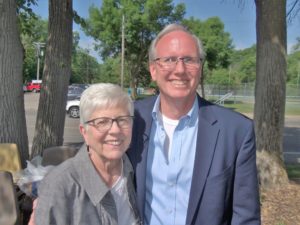
State Rep. Tim O’Driscoll (R-Sartell) was a guest speaker at the Memorial Day ceremony in Sartell. His mother, Joyce O’Driscoll, was the moderator of the event. Rep. O’Driscoll started the Memorial Day ceremony as it’s performed today more than a decade ago in Veterans Park. Since then, attendance has been excellent every year, rain or shine.



